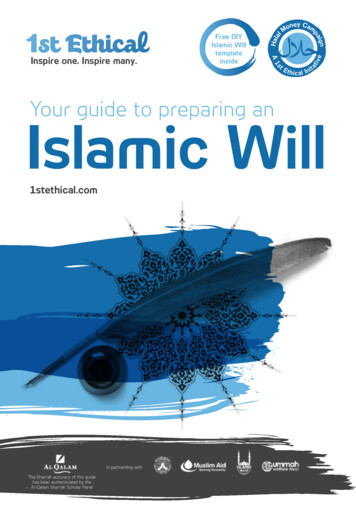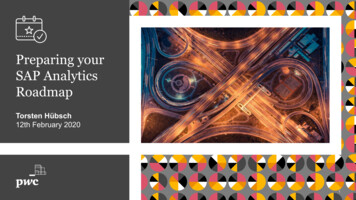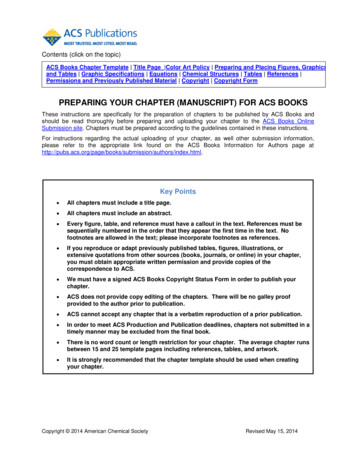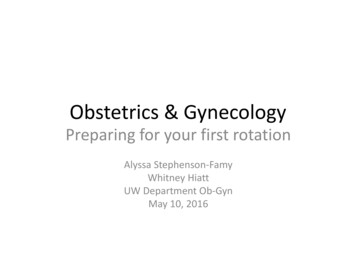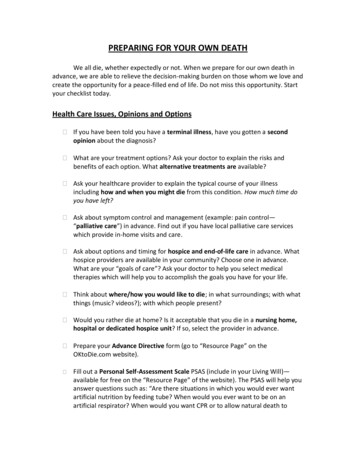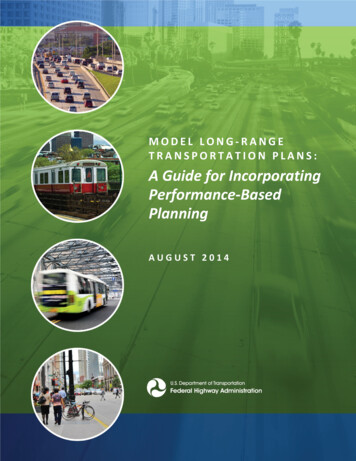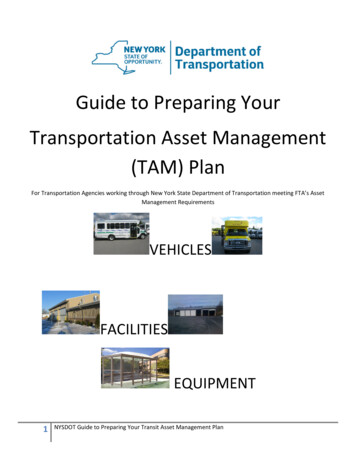
Transcription
Guide to Preparing YourTransportation Asset Management(TAM) PlanFor Transportation Agencies working through New York State Department of Transportation meeting FTA’s AssetManagement RequirementsVEHICLESFACILITIESEQUIPMENT1NYSDOT Guide to Preparing Your Transit Asset Management Plan
AcknowledgementsThis guide was prepared using elements of the Washington StateDepartment of Transportation’s “Guide to Preparing Your TransitAsset Management Plan” (February, 2005), the U.S. Department ofTransportation’s Federal Transit Administration’s FY 2015 Triennial ReviewWorkshop Workbook” and their “Asset Management Guide”, and theirMaster Agreement, FTA’s Circular 5010.1D, Page I-6 (Rev. 1: 8/27/2012), andChicago’s Transit Asset Management System (CTA) July 2011.2NYSDOT Guide to Preparing Your Transit Asset Management Plan
IntroductionBackground on the requirements What is required?Where did the requirement come from?Who must have a plan?Which assets are covered by the plan?Plan Submission When are the plans due? Where do I submit my plans?Plan RequirementsDeveloping your plan1. Mission statement2. List of assetsA. Vehicle InventoryB. Equipment InventoryC. Facility Inventory3. Accountability List4. Reporting system5. Inspections and Preventive maintenanceA. Vehicle Maintenance PlanB. Equipment Maintenance PlanC. Facility Maintenance Plan6. Incidental Use7. Warranties, manufacturer’s updates, and recalls8. Third party maintenance plan9. Persons with Disabilities10. Asset Management Resources3NYSDOT Guide to Preparing Your Transit Asset Management Plan
AppendicesA: County/System Specialist ListingB: NYS Vehicle/Equipment Disposition PolicyC: Rolling Stock InventoryD: Equipment InventoryE: Equipment Maintenance PlanF: Facility InventoryG: Facility Condition FormH: Building Safety ChecklistI: Pre/Mid/Post Trip Inspection FormJ: Lift Inspection Report FormK: Maintenance Plan TemplateL: Helpful WebsitesM: Rolling Stock Status Report4NYSDOT Guide to Preparing Your Transit Asset Management Plan
IntroductionBackground on the requirementsWhat is required?As a condition of receiving federal transit funds, transportation providers are requiredto maintain and produce upon request, an asset management plan to the New York State Department ofTransportation for certification. The plan must inventory all Federal Transit Administration (FTA) fundedtransportation system assets and provide a sustainable plan based on lowest life-cycle costmethodologies.Where did the requirement come from?In referencing 49 U. S. C. Chapter 53, Federal Transit Laws, 49 CFR Part 18 “UniformAdministrative Requirements for Grants and Cooperative Agreements to State and Local Governments”,49 CFR 37 “Transportation Services for Individuals With Disabilities (ADA)”, FTA Circular 5010.1D “GrantManagement Requirements”, FTA Circular 9030.1E, “Urbanized Area Formula Program: ProgramGuidance and Application Instructions”, and the FTA Master Agreement, this guide has been compiled tohelp transportation agencies in conforming with FTA regulations.Who must have a plan?Every sub-recipient of NYSDOT that receives Federal funds (Section 5311, Section 5310,etc .) must have an on-site Transportation Asset Management (TAM) Plan. A Transportation AssetManagement Plan MUST BE on file in EVERY location that the recipient has federal assets.Which assets are covered by the plan?The Federal Transit Administration requires that each recipient of federal funds includein their Transportation Asset Management Plan, an inventory of those assets bought using federal fundsincluding: 5All rolling stock (passenger service vehicles)Facilities with a replacement value of 5,000 or more.Equipment with a replacement value of 5,000 or more. Equipmentmeans all tangible, nonexpendable, personal property that has auseful life of more than one year and an acquisition cost that exceeds 5,000 per unit.Non-federally funded facility/ies used to store and/or maintain federallyfunded vehicle/s and equipment/s.NYSDOT Guide to Preparing Your Transit Asset Management Plan
Plan SubmissionWhen are the plans due?The initial plan, based on this guide, is due by June 30, 2016. Updates to plans are duewithin 90 days of receipt of federally funded assets. Plans can be sent electronically or by mail. Eachtime an asset is acquired, retired, or transferred, an updated inventory must be sent in to the NYSDOTSystem Specialist. If an asset is being retired or disposed of, please note Appendix B: NYS EquipmentDisposition/Spare Vehicle Policy.Where do I submit my plans?Plans are to be sent to the attention of your NYS DOT’s System Specialist in the PublicTransportation Bureau. It can be sent electronically or by mail. A current listing of Counties and theirrespective System Specialist is located in Appendix A: County/System Specialist Listing.Attn: [System Specialist]NYS Dept. of TransportationPublic Transportation Bureau50 Wolf Rd.-POD 5-4Albany, NY 122326NYSDOT Guide to Preparing Your Transit Asset Management Plan
Plan RequirementsDeveloping Your PlanThis section provides guidance on what the plans must contain.1. Mission StatementEvery Transportation Asset Management Plan should start with a mission statement. Amission statement sets goals and objectives for asset management and includes the principals thatguide a responsible PM program. Below is a sample:“It is the policy of the XXX Transportation Agency to adhere to an effective and properPreventative Maintenance (PM) Program for FTA funded facilities, facility-related equipment, and transitvehicles. This PM will meet or exceed the vehicle/facility/equipment manufacturer’s recommendationsin order to ensure the availability of safe, high quality public transportation services and maximize usefulservice life of facilities, equipment and vehicles. Also, a proper inventory will be kept of all vehicles,facilities, and equipment over 5,000.”2.List of assetsThe asset management plan must include an inventory of all federally fundedtransportation assets, not only vehicles, but facilities and equipment. These inventories are not onlyreviewed triennially by FTA but also input into the National Transit Database (NTD) by NYSDOT annually.This information will also be used as part of the NYSDOT multi-year capital program plan process.Please pay close attention to your vehicle/equipment’s useful life. Refer to Appendix B:NYS Vehicle/Equipment Disposition Policy when your vehicle or your equipment is within one to twoyears of reaching its useful life. It takes time to order, manufacture, and/or deliver vehicles and/orequipment, so you should plan to apply for another vehicle or equipment in the next grant applicationwhen the vehicle is 1 to 2 years away from meeting its useful life.7NYSDOT Guide to Preparing Your Transit Asset Management Plan
A.Vehicle InventoryRolling stock needs to be inventoried. The Appendix C: Rolling Stock Inventory formshould be used to help you keep track of your vehicle inventory. This should be updated every time theinventory changes; whether receipt of a new vehicle, retirement of a vehicle, or transfer of a vehicle,and yearly when sending in your annual report. A copy should be sent to your System Specialist atNYSDOT when this occurs. The form can be sent electronically as a signed PDF or via mail. Pleasehighlight the change/s in the inventory when sending it.To start, the first section asks for the locations of your vehicles. Some sub recipients havevarious locations for their vehicles. The location numbers on the side of this section will be used in thenext section to tell us where EACH vehicle is located.The second section asks for information on each INDIVIDUAL vehicle. Starting with the locationnumber from the section above this one, fill information in for each vehicle.Please pay special attention to a few items: Note that the Year of Manufacture is NOT the yearyou receive the vehicle. It should be the year that the vehicle was manufactured. This informationshould be on the door jam of the vehicle, on the Data Sticker. Also, the Vehicle Length should be given inFeet.Appendix C: Rolling Stock Inventory Form GuideLocation NumberNumber from section above. Where vehicle is located.Agency Vehicle NumberWhat number your agency has given this vehicleYearYear of Manufacture (Not the year you received the vehicle)MakeExamples: Coach and Equipment, Starcraft, Champion, etc ModelExamples: Defender, Phoenix, Allstar, etc VINVehicle Identification Number found on lower right corner under windshieldand/or on Data Sticker which is either in driver’s door or in passenger’sstepwell.Current OdometerMiles on vehicle (as of date form certification signed)Vehicle TypeAO-automobile, BU-bus, CU-cutaway, MV-minivans, BR-Over-theroad bus, SV-sports utility vehicle, VN-vansVehicle Length (Feet)Bumper to bumper IN FEETSeating CapacityNumber of Seats on Bus8NYSDOT Guide to Preparing Your Transit Asset Management Plan
Wheelchair PositionsNumber of Wheel Chair StationsFuel TypeType of FuelConditionThe condition of the vehicles should be broken down as such:1-Excellent2-Good3-Poor4-Needs ReplacementVehicle Status1. Active Route Deviation, 2. Active Demand Response, 3. ActiveCommuter/Intercity, 4. Active Fixed Route, 5. ActiveComplementary Paratransit, 6. Spare, 7. Reserve, 8. PendingDisposalOwnership Code1. Leased By Public Agency for Service Provider, 2. Owned By PublicAgency for Service Provider, 3. Leased By Service Provider, 4.Owned By Service ProviderLargest Source of Fundingfor Purchase/Lease ofVehicleOther Federal, FTA, Private, State or LocalOut of Service for MoreThan 14 Days (Yes or NO)If out of service for more than 14 days, give dates and reasons, on Commentpage.B.Equipment InventoryEquipment with a replacement value of 5,000 or more, need to be inventoried. Equipmentmeans all tangible, nonexpendable, personal property that has a useful life of more than one yearand an acquisition cost that exceeds 5,000 per unit.Appendix D: Equipment Inventory Form should be used to keep track of this inventory. Thisinformation should be updated every time the inventory changes; whether receipt of new equipment,retirement of equipment meeting its useful life expectancy, or transfer of equipment.9NYSDOT Guide to Preparing Your Transit Asset Management Plan
Appendix D: Equipment Inventory Form GuideAgency Equipment ID NumberWhat number your agency has given this vehicleEquipment Name and DescriptionExamples: Mohawk Lift, Ticketing Kiosk,Condition (Points)The condition of the vehicles should be broken down as such:1-Excellent2-Good3-Poor4-Needs ReplacementYear AcquiredYear you received the Equipment in your agencyRemaining Useful Life (Years)Years left before needs replacing or retired.CommentsAnything we should know? (Breaks down a lot, best value, etc .)This information may be used for future procurements.C.Facility InventoryAs with equipment, facilities with a replacement value of 5,000 or more needs to beinventoried. The proper maintenance of a facility is key to protecting the FTA investment and prolongingthe useful life of the asset.Appendix E: Facility Inventory Form and Appendix F: Facility Component Condition Form shouldbe used to keep track of facility assets and components. This information should be updated every timethere is a change to the facility or a component. Please note that the “Location Number” on the formrelates back to forms Appendix C & D Location Numbers. If you have more than one facility, fill out aseparate form for each facility as needed.10NYSDOT Guide to Preparing Your Transit Asset Management Plan
3.Accountability ListThe way in which the agency’s maintenance procedures are organized and staffed, along withthe experience of maintenance staff should be commensurate with the agency’s size and complexity.The type, frequency, and method of training provided to staff about FTA requirements and industry bestpractices are important indicators of the grantee’s technical competency in the management of FTAassets.Grantee’s senior management should be well informed on matters pertaining to preventivemaintenance of all FTA-funded assets. The presence of regularly recurring reports with specificperformance measures tied to the grantee’s written maintenance plans, including manufacturer’srecommendations, and other actionable management data, indicates that senior management ismonitoring maintenance activities.A listing of each person involved in Preventative and Asset Management, as well as their trainingand responsibilities should be provided in your plan. FTA, NYSDOT, and company training requirements,certifications, and Best Practices requirements should be listed also. A model program for FTA fundedfacilities would include an organization and assignment of responsibility for facility and equipmentmaintenance.4.Reporting SystemEach agency should have a record keeping system; either computerized or manual. Theagency should be able to identify, track, and report on the inventory it has received. Not only will thisreporting system be used to submit reports for NYSDOT and FTA, but this system should be useful forpredicting future needs as federal funding becomes available. Maintenance, repairs, and preservationactivities should be easily accessible to state and federal reviewers. In your plan, provide a description ofthe method used by your organization to track these issues.5.Inspections and Preventive MaintenanceA listing of inspections and preventive maintenance and interval periods done on federallyfunded vehicles, equipment, and facilities and non-federally funded facilities used to store and/ormaintain federally funded vehicles and equipment, should be in your Asset Management Plan. If anyforms are used, please supply an example of each form. Sample forms can be found under Appendix G,H, I & J.A.A vehicle maintenance plan should list interval periods for inspections andmaintenance for each type of vehicle and specifics on where this inspection and maintenance is done.This relates to whether the inspection and maintenance is done in-house or contracted out. There needsto be a record or paper trail no matter who does the inspections and maintenance.11NYSDOT Guide to Preparing Your Transit Asset Management Plan
B.An equipment maintenance plan should also list interval periods for inspectionsand maintenance and whether the inspection and maintenance is done in-house or contracted out.C.A facility maintenance plan should identify specific mission critical and safetyitems, which include, but are not limited to:Buildings, elevators, escalators, passenger stations/shelters, parking lots, rights-of-way(guideway, track, ballast, etc.), electric distribution and control equipment, plumbing systems, overheaddoors, vehicle maintenance lifts, vehicle washers and wash water recycling systems, heating and/or airconditioning units, power substations, security equipment, etc.The facility maintenance program should describe a system of periodic inspections andpreventive maintenance to be performed at certain defined intervals. Intervals can be measured interms of time (daily, monthly, or annually) or in terms of usage (hours of use).6.Incidental UseIf a facility, vehicle or equipment has been acquired with FTA funds for purposes of transitservice, is also being used for non-transit use (Incidental Use) due to transit operating circumstances,this incidental use needs prior approval. Such use must be compatible with the approved purposes ofthe project and not interfere with intended public transportation uses of project assets. Please contactyour system Specialist if you are going to use a FTA funded asset for any non-transit use. The SystemSpecialist will ask for approval from FTA and send you an approval letter. This letter must be kept on filefor the life of the asset and/or the duration of the incidental use.7.Warranties, Manufacturer’s Updates, and RecallsA transportation agency must have a process that tracks warranty repairs, manufacturer’supdates and recalls and ensures that a person or contractor that is certified by the applicablemanufacturer, completes the repairs. If your transportation system employee makes the warrantyrepairs, you need to make sure that you obtain approval from the manufacturer. Describe the process oftracking such warranty repairs, manufacturer updates and recalls. There should be clear procedures toidentify warranty repairs, record the warranty claim, submit the claim to the manufacturer, and followup on unpaid claims. By reporting warranty and recall actions to NYSDOT, the state can use this info forfuture bid opportunities and specifications.8.Third Party Maintenance PlanGrantees that have elected to hire out their maintenance functions are still responsible for themaintenance of their FTA funded assets. Regardless of who operates and maintains these assets, theseoperations and maintenance issues need to be documented. The grantee must have an effectivemechanism to monitor subrecipients’, contractors’, and lessees’ maintenance activities. An acceptableprogram would consist of periodic written reports on maintenance activities submitted to the grantee12NYSDOT Guide to Preparing Your Transit Asset Management Plan
supplemented by review of maintenance records and periodic inspections of the FTA funded vehicles,equipment and facilities. As with grantees that do their own facility, equipment and vehiclemaintenance, an accountability list should be in place with names, titles, and responsibilities for thethird party.9.Persons with DisabilitiesYour Asset Management Plan must have written directions as to how you deal withaccessibility features, such as wheelchair lifts, ramps, securement devices, signs, and communicationequipment for persons with disabilities. These features must be repaired promptly. If they are unable tobe repaired promptly, a system must be in place to accommodate persons with disabilities who wouldotherwise use it. These directions may be incorporated into your regular asset management plan oraddressed separately.10.Asset Management ResourcesAppendix K: Helpful Websites has been added as a resource for your agency.13NYSDOT Guide to Preparing Your Transit Asset Management Plan
14NYSDOT Guide to Preparing Your Transit Asset Management Plan
Appendix A: County/System Specialist ListingSPONSOR(Sub-Recipient)DOT System SpecialistNumberNassau CountyMarc.boucher@dot.ny.gov(518) 457-8366Albany CountyRichard.Lenseth@dot.ny.gov(518) 457-1580New York CountyGennadiy.kosoy@dot.ny.gov(518) 485-1804Allegany CountyJohn.reel@dot.ny.gov(518) 457-8368Niagara CountyJohn.reel@dot.ny.gov(518) 457-8368Broome CountyChris.nweke@dot.ny.gov(518) 457-8356Oneida CountyLaura.Hacker@dot.ny.gov(518) 457-8346Cattaraugus CountyJohn.reel@dot.ny.gov(518) 457-8368Onondaga CountyLaura.Hacker@dot.ny.gov(518) 457-8346Cayuga CountyLaura.Hacker@dot.ny.gov(518) 457-8346Ontario CountyLaura.Hacker@dot.ny.gov(518) 457-8346Chautauqua CountyJohn.reel@dot.ny.gov(518) 457-8368Orange CountyJonathan.Cmyalo@dot.ny.gov(518) 457-0250Chemung CountyChris.nweke@dot.ny.gov(518) 457-8356Orleans CountyLaura.Hacker@dot.ny.gov(518) 457-8346Chenango CountyChris.nweke@dot.ny.gov(518) 457-8356Oswego CountyLaura.Hacker@dot.ny.gov(518) 457-8346Clinton CountyRichard.Lenseth@dot.ny.gov(518) 457-1580Otsego CountyLaura.Hacker@dot.ny.gov(518) 457-8346Putnam CountyJonathan.Cmyalo@dot.ny.gov(518) 457-0250Columbia CountyJonathan.Cmyalo@dot.ny.gov(518) 457-0250Cortland CountyChris.nweke@dot.ny.gov(518) 457-8356Rensselaer CountyRichard.Lenseth@dot.ny.gov(518) 457-1580Delaware CountyJonathan.Cmyalo@dot.ny.gov(518) 457-0250Richmond CountyGennadiy.kosoy@dot.ny.gov(518) 485-1804Dutchess CountyJonathan.Cmyalo@dot.ny.gov(518) 457-0250Rockland CountyJonathan.Cmyalo@dot.ny.gov(518) 457-0250Erie CountyJohn.reel@dot.ny.gov(518) 457-8368Saratoga CountyRichard.Lenseth@dot.ny.gov(518) 457-1580Schenectady CountyRichard.Lenseth@dot.ny.gov(518) 457-1580Esse
Every Transportation Asset Management Plan should start with a mission statement. A mission statement sets goals and objectives for asset management and includes the principals that guide a responsible PM program. Below is a sample: “It is the policy of the XXX Transportation
